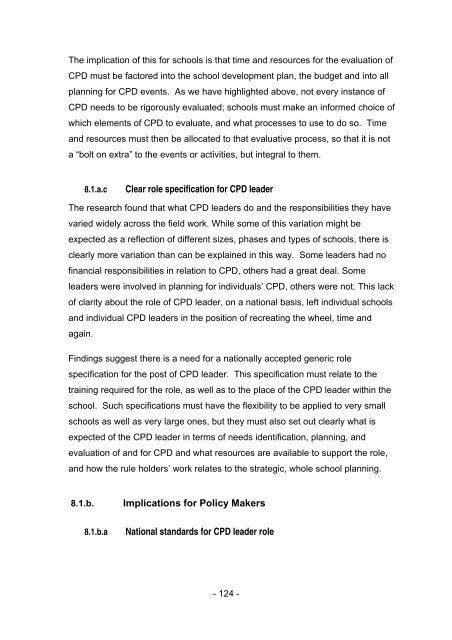Evaluating the Impact of Continuing Professional Development (CPD)
Evaluating the Impact of Continuing Professional Development (CPD)
Evaluating the Impact of Continuing Professional Development (CPD)
Create successful ePaper yourself
Turn your PDF publications into a flip-book with our unique Google optimized e-Paper software.
The implication <strong>of</strong> this for schools is that time and resources for <strong>the</strong> evaluation <strong>of</strong><br />
<strong>CPD</strong> must be factored into <strong>the</strong> school development plan, <strong>the</strong> budget and into all<br />
planning for <strong>CPD</strong> events. As we have highlighted above, not every instance <strong>of</strong><br />
<strong>CPD</strong> needs to be rigorously evaluated; schools must make an informed choice <strong>of</strong><br />
which elements <strong>of</strong> <strong>CPD</strong> to evaluate, and what processes to use to do so. Time<br />
and resources must <strong>the</strong>n be allocated to that evaluative process, so that it is not<br />
a “bolt on extra” to <strong>the</strong> events or activities, but integral to <strong>the</strong>m.<br />
8.1.a.c<br />
Clear role specification for <strong>CPD</strong> leader<br />
The research found that what <strong>CPD</strong> leaders do and <strong>the</strong> responsibilities <strong>the</strong>y have<br />
varied widely across <strong>the</strong> field work. While some <strong>of</strong> this variation might be<br />
expected as a reflection <strong>of</strong> different sizes, phases and types <strong>of</strong> schools, <strong>the</strong>re is<br />
clearly more variation than can be explained in this way. Some leaders had no<br />
financial responsibilities in relation to <strong>CPD</strong>, o<strong>the</strong>rs had a great deal. Some<br />
leaders were involved in planning for individuals’ <strong>CPD</strong>, o<strong>the</strong>rs were not. This lack<br />
<strong>of</strong> clarity about <strong>the</strong> role <strong>of</strong> <strong>CPD</strong> leader, on a national basis, left individual schools<br />
and individual <strong>CPD</strong> leaders in <strong>the</strong> position <strong>of</strong> recreating <strong>the</strong> wheel, time and<br />
again.<br />
Findings suggest <strong>the</strong>re is a need for a nationally accepted generic role<br />
specification for <strong>the</strong> post <strong>of</strong> <strong>CPD</strong> leader. This specification must relate to <strong>the</strong><br />
training required for <strong>the</strong> role, as well as to <strong>the</strong> place <strong>of</strong> <strong>the</strong> <strong>CPD</strong> leader within <strong>the</strong><br />
school. Such specifications must have <strong>the</strong> flexibility to be applied to very small<br />
schools as well as very large ones, but <strong>the</strong>y must also set out clearly what is<br />
expected <strong>of</strong> <strong>the</strong> <strong>CPD</strong> leader in terms <strong>of</strong> needs identification, planning, and<br />
evaluation <strong>of</strong> and for <strong>CPD</strong> and what resources are available to support <strong>the</strong> role,<br />
and how <strong>the</strong> rule holders’ work relates to <strong>the</strong> strategic, whole school planning.<br />
8.1.b.<br />
Implications for Policy Makers<br />
8.1.b.a<br />
National standards for <strong>CPD</strong> leader role<br />
- 124 -

















